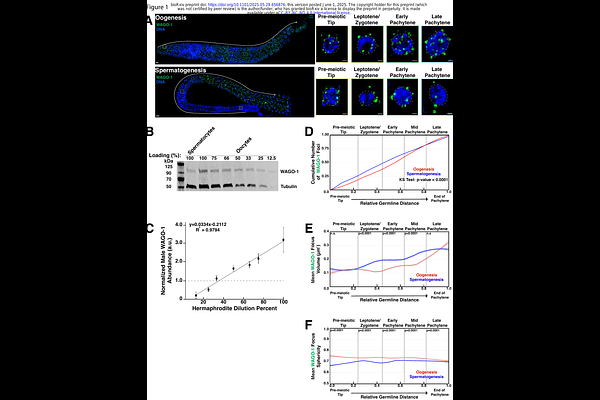WAGO-1 is a sexually dimorphic Argonaute protein required for proper germ granule structure and gametogenesis

WAGO-1 is a sexually dimorphic Argonaute protein required for proper germ granule structure and gametogenesis
DiNardo, A. L.; Kurhanewicz, N. A.; Wilson, H. R.; Berg, V.; Libuda, D. E.
AbstractGerm cell proliferation and proper genome inheritance are critical for maintaining fertility through generations. To promote proper germ cell development, small RNA pathways employ Argonaute proteins (AGOs) to modulate gene expression and protect against deleterious genomic elements while not silencing against self. Here we identify sexual dimorphisms in localization and function of protein structural features of the Argonaute WAGO-1 that affects sex-specific gene regulation during C. elegans germ cell development. During meiotic prophase I progression, we find that germ granule structural proteins and the PIWI AGO, PRG-1, display dynamic and distinct localization patterns between egg and sperm development which coincide with differential WAGO-1 localization and biophysical properties. Sexually dimorphic functions of specific WAGO-1 protein structural domains underpin these differences. Disruption or modification to the N-terminus intrinsically disordered region (IDR) of WAGO-1 leads to loss of PGL-1 phase separation only during spermatogenesis. Further, we find that these germ granule disruptions are likely due to prolonged association of the IDR with the RNA-binding pocket of WAGO-1. In addition, deletion of the MID and part of the PIWI domains causes male-specific sterility and disruption to WAGO-1 localization with PGL-1 during oogenesis. Finally, we demonstrate that these disruptions to WAGO-1 protein structure dynamically change the mRNA and sRNA landscape of adult males and hermaphrodites, in which the AGOs ALG-3/4 and VSRA-1 are misregulated. Together, these data suggest that WAGO-1 differentially regulates genes during oogenesis versus spermatogenesis, and that these differences in gene regulation may be due to the sex-specific configuration and biophysical properties of WAGO-1 within the germ granule.